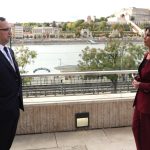World-Class Robot-Assisted Devices Support Patient Recovery at the Debrecen Clinic
In addition to showcasing cutting-edge robot-assisted technologies, participants of the Hungarian Rehabilitation Society’s annual conference in Debrecen were introduced to the latest therapeutic options, pain management strategies, physical performance enhancement techniques, and patient rights issues.
This was the third time the conference was held in Debrecen and the three-day event, which began on Thursday, was hosted by the Department and Clinic of Medical Rehabilitation and Physical Medicine at the Faculty of General Medicine, University of Debrecen.
“The importance of this field at our university is reflected in the significant infrastructure and equipment investments made in recent years, supported largely by our own resources,” Zoltán Bács, Chancellor of the University of Debrecen, emphasized in his welcome speech, adding that over the past 2–3 years, approximately HUF 600 million worth of equipment development has been realized, providing access to the most modern tools necessary for effective rehabilitation. He pointed out that they trust that the university will continue to support the growth of this field and the clinic, contributing to the maintenance of high professional standards.
Zoltán Szabó, President of the Clinical Center, added that thanks to recent developments, the Clinic of Medical Rehabilitation and Physical Medicine at the University of Debrecen now complements traditional therapeutic methods with world-class robot-assisted devices to aid patient recovery.
László Mátyus, Dean of the Faculty of General Medicine, noted that the scientific presentations at the congress will be integrated into medical education, drawing future doctors’ attention to the importance of the field.
The professional event was opened by Péter Cserháti, President of the Hungarian Rehabilitation Society. Special attention was given to improving physical performance in specific patient groups, such as those with cardiac conditions, extreme obesity, or recovering from stroke. Attendees heard presentations on the rehabilitation of traumatology and orthopedic patients, as well as the roles of psychology, speech therapy, and sports in rehabilitation. Innovative solutions in pulmonary rehabilitation were also showcased. The conference addressed modern approaches to pain management, including pharmaceutical, physiotherapeutic, and psychological methods.
“We aimed for a practical and interdisciplinary approach when selecting the main topics and organizing the symposiums, involving multiple related professions,” Zoltán Jenei, Chair of the Scientific Committee and Associate Professor at the University of Debrecen’s Department of Medical Rehabilitation and Physical Medicine explained, adding that participants also received insights into the modern rehabilitation of rheumatology, amputee, renal, and pulmonary patients. New additions to the program included presentations on patient rights, communication, and information provision.
Policy-focused roundtable discussions provided comprehensive information on changes in assistive device prescriptions and on undergraduate and postgraduate training.
Around 400 professionals attended the Hungarian Rehabilitation Society’s annual conference held October 9–11 at the Kölcsey Center.
Source: dehir.hu | Photo credit: Facebook (Kölcsey Központ Debrecen)


